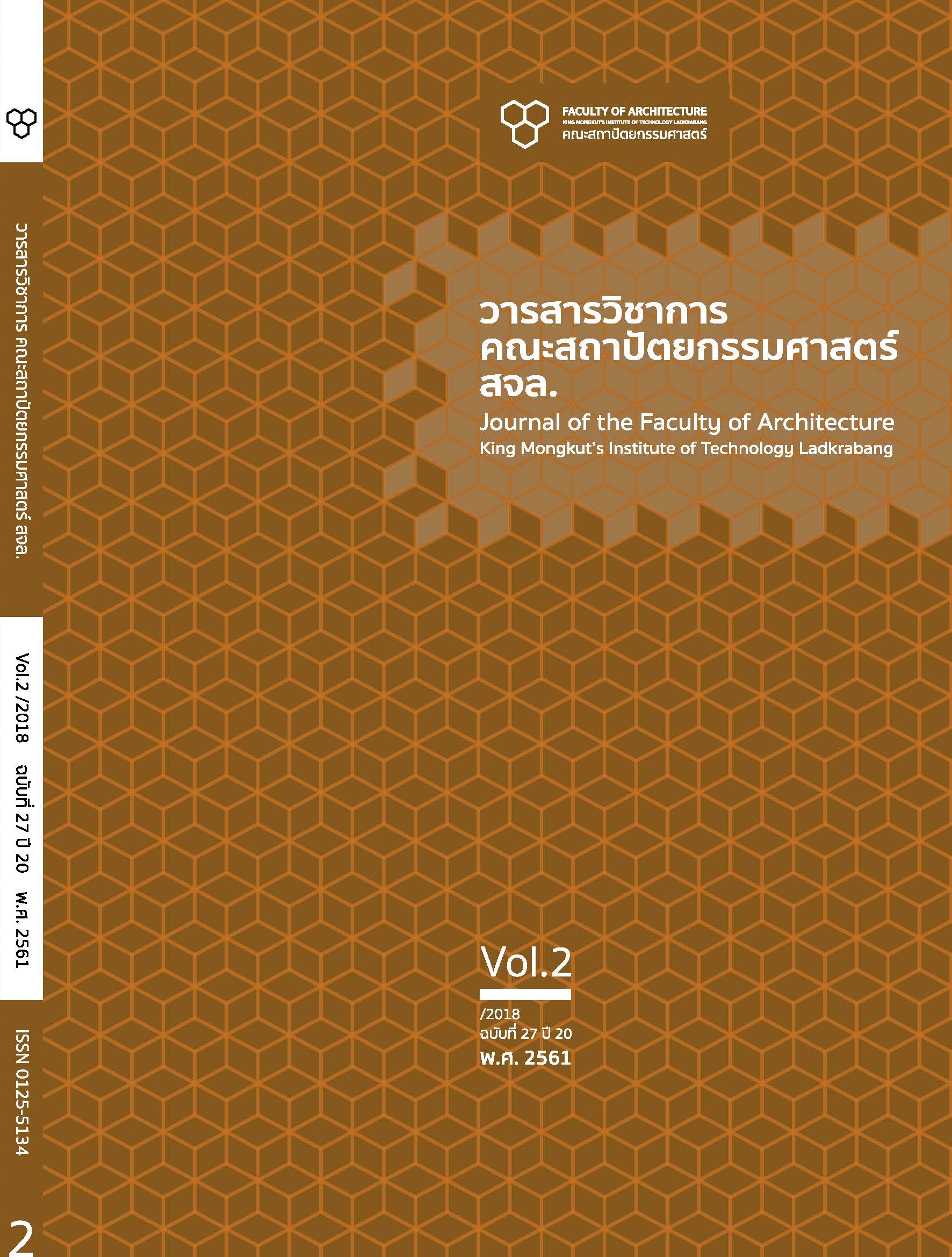แนวทางการพัฒนาละแวกบ้านและย่านในเมืองเชียงใหม่ Development of Neighbourhood and Districts of Chiang Mai City
Main Article Content
Abstract
บทคัดย่อ
บทความนี้มีวัตถุประสงค์ที่จะศึกษาปัจจัยที่มีส่วนในการกำหนดความเป็นละแวกบ้านและย่านในเมืองเชียงใหม่ รวมทั้งการวิเคราะห์การซ้อนทับของมิติทางกายภาพ สังคม กิจกรรม วิถีชีวิต และความเชื่อของคนในเมืองที่มีส่วนในการ กำหนดย่านเพื่อใช้เป็นแนวทางในการเสนอแนะการกำหนดหน่วยพื้นที่ที่เหมาะสมสำหรับการวางแผนพัฒนาเมือง หรือผังเมืองที่ไม่ได้สะท้อนลักษณะเฉพาะของพื้นที่และส่งผลให้เกิดการทำลายคุณค่าเมืองที่มีอยู่เดิม
จากการศึกษาพบว่าย่านในเมืองเชียงใหม่แบ่งออกเป็น 14 ย่านและละแวกบ้านอีกจำนวนมาก โดยเป็นย่านฝั่งตะวันออกแม่น้ำปิง 11 ย่าน และฝั่งตะวันตกของแม่น้ำปิงอีก 3 ย่าน จะเห็นได้ว่าฝั่งตะวันตกเกือบทั้งหมดเกี่ยวข้องกับความเป็นเมืองเก่าของเชียงใหม่ ส่วนพื้นที่ฝั่งตะวันออก เฉพาะบริเวณที่ติดแม่น้ำปิงจะมีลักษณะเป็นเมืองเก่ามากกว่าพื้นที่ที่ห่างไกลออกไป ถนนซุปเปอร์ไฮเวย์นับเป็นขอบเขตย่านที่ชัดเจนที่สุดในปัจจุบัน ดังนั้นพื้นที่นอกถนนซุปเปอร์ไฮเวย์ ออกไปจึงเหมาะสมสำหรับรองรับการเติบโตหรือการพัฒนาเมืองใหม่ ขณะที่พื้นที่ทางตะวันตกของถนนซุปเปอร์ไฮเวย์ไปจนจรดพื้นที่ดอยสุเทพ ควรกันเป็นพื้นที่อนุรักษ์ที่มีอาคารสูงปานกลางถึงต่ำเพื่อรักษาบรรยากาศเมืองเก่า โดยเฉพาะในเขตกำแพงเมืองชั้นในและชั้นนอก ที่ได้กำหนดเป็นเขตเพื่อการอนุรักษ์ศิลปวัฒนธรรมไทยในผังเมืองรวมฉบับใหม่ การนำลักษณะเฉพาะของแต่ละย่านและละแวกบ้านเข้ามาเป็นส่วนหนึ่งของการวางแผนและออกแบบเมืองเป็นสิ่งจำเป็นอย่างยิ่งสำหรับการพัฒนาที่ยั่งยืนสำหรับอนาคต
คำสำคัญ: ละแวกบ้าน ย่านในเมืองเชียงใหม่ การพัฒนาเมือง พื้นที่อนุรักษ์และการพัฒนาที่ยั่งยืน
Abstract
The paper aim at identifying neighbourhood and districts of Chiang Mai City through various factors. Considering that “place characteristic” has not been a major aspect for planners and architects in planning and design the city. As a result, many plans pay no respects to valuable assets of place, for example: suggest road widening or allow high rises in historic areas.
This paper found there are 14 districts in Chiang Mai, with many relatively small neighbourhood. Most of the districts, 11 out of 14, are on the west side of Ping River, while only 3 districts are on the east side. Almost all of west side districts are connected to the history of Chiang Mai in some ways. The Super Highway Road is most legible edge, it can also be used to identify the boundary of the old area of the city. The area outside the Super Highway Road can be developed as the “new town” for Chiang Mai, while the area to the west should be designated as “conserved area” with medium to low rise development, especially the area within the old city walls. Each district characters should be assimilated in the planning and design of the city for a more sustainable future.
Keywords: Neighbourhood, Districts of Chiang Mai City, Urban Development, Conserved Area and Sustainable Development
Article Details
This work is licensed under a Creative Commons Attribution-NonCommercial-ShareAlike 4.0 International License.
Copyright Transfer Statement
The copyright of this article is transferred to Journal of The Faculty of Architecture King Mongkut's Institute of Technology Ladkrabang with effect if and when the article is accepted for publication. The copyright transfer covers the exclusive right to reproduce and distribute the article, including reprints, translations, photographic reproductions, electronic form (offline, online) or any other reproductions of similar nature.
The author warrants that this contribution is original and that he/she has full power to make this grant. The author signs for and accepts responsibility for releasing this material on behalf of any and all co-authors.
References
ปรานอม ตันสุขานันท์ และวิทยา ดวงธิมา (2556) แนวทางการพัฒนาความเป็นย่านหลากมิติของเมืองเชียงใหม่.
คณะสถาปัตยกรรมศาสตร์และการออกแบบสิ่งแวดล้อม มหาวิทยาลัยแม่โจ้.
ปรานอม ตันสุขานันท์ และวิทยา ดวงธิมา (2560) ความรู้สึกเป็นสถานที่ของชุมชนละแวกบ้านในเขตเมืองประวัติศาสตร์ เชียงใหม่. วารสารสิ่งแวดล้อมสรรค์สร้างวินิจฉัย คณะสถาปัตยกรรมศาสตร์ มหาวิทยาลัยขอนแก่น. 16, 85-107.
พัฒนา กิติอาษา (2546). ท้องถิ่นนิยม. พิมพ์ ครั้งที่ 2. เชียงใหม่: กองทุนอินทร์สมเพื่อการวิจัยทางมานุษยวิทยา.
วรชัย ทองไทย (2554). การเปลี่ยนแปลงประชากรโลก 2493-2573. ประชากรและสังคม 2554. 317-330.
อรุณรัตน์ วิเชียรเขียว และสุรพล ดาริห์กุล (2539) วัดร้างในเวียงเชียงใหม่. สุริวงศ์บุ๊คเซนเตอร์. เชียงใหม่: พิมพ์ครั้งที่ 2
แก้ไขปรับปรุงและเพิ่มเติมภาพ.
Garnham, H. L. (1985). Maintaining the Spirit of Place: a Process for the Preservation of Town Character. Mesa: PDA Publishers Corporation.
Ling, A. and Johnson, D.K. (1943). Bubble diagram of London. Sketchbook City. London: County of London Plan.


